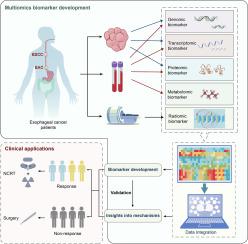Pharmacology & Therapeutics ( IF 13.5 ) Pub Date : 2024-01-28 , DOI: 10.1016/j.pharmthera.2024.108591 Zhi Yang , Fada Guan , Lawrence Bronk , Lina Zhao

|
Neoadjuvant chemoradiotherapy (NCRT) followed by surgery has been established as the standard treatment strategy for operable locally advanced esophageal cancer (EC). However, achieving pathologic complete response (pCR) or near pCR to NCRT is significantly associated with a considerable improvement in survival outcomes, while pCR patients may help organ preservation for patients by active surveillance to avoid planned surgery. Thus, there is an urgent need for improved biomarkers to predict EC chemoradiation response in research and clinical settings. Advances in multiple high-throughput technologies such as next-generation sequencing have facilitated the discovery of novel predictive biomarkers, specifically based on multi-omics data, including genomic/transcriptomic sequencings and proteomic/metabolomic mass spectra. The application of multi-omics data has shown the benefits in improving the understanding of underlying mechanisms of NCRT sensitivity/resistance in EC. Particularly, the prominent development of artificial intelligence (AI) has introduced a new direction in cancer research. The integration of multi-omics data has significantly advanced our knowledge of the disease and enabled the identification of valuable biomarkers for predicting treatment response from diverse dimension levels, especially with rapid advances in biotechnological and AI methodologies. Herein, we summarize the current status of research on the use of multi-omics technologies in predicting NCRT response for EC patients. Current limitations, challenges, and future perspectives of these multi-omics platforms will be addressed to assist in experimental designs and clinical use for further integrated analysis.
中文翻译:

用于预测食管癌新辅助治疗反应的生物标志物发现的多组学方法:多维视角
新辅助放化疗(NCRT)加手术已成为可手术的局部晚期食管癌(EC)的标准治疗策略。然而,NCRT 实现病理完全缓解 (pCR) 或接近 pCR 与生存结果的显着改善显着相关,而 pCR 患者可以通过主动监测来帮助患者保留器官,以避免计划手术。因此,迫切需要改进的生物标志物来预测研究和临床环境中的 EC 放化疗反应。新一代测序等多种高通量技术的进步促进了新型预测生物标志物的发现,特别是基于多组学数据,包括基因组/转录组测序和蛋白质组/代谢组质谱。多组学数据的应用显示了在提高对 EC NCRT 敏感性/耐药性潜在机制的理解方面的好处。特别是人工智能(AI)的突出发展为癌症研究引入了新的方向。多组学数据的整合极大地提高了我们对该疾病的认识,并能够识别有价值的生物标志物,用于从不同维度水平预测治疗反应,特别是随着生物技术和人工智能方法的快速发展。在此,我们总结了使用多组学技术预测 EC 患者 NCRT 反应的研究现状。这些多组学平台当前的局限性、挑战和未来前景将得到解决,以协助实验设计和临床使用,以进行进一步的综合分析。



























 京公网安备 11010802027423号
京公网安备 11010802027423号